READ this entire installation guide before beginning your installation.
ACP is not responsible and will not be held liable for project failures if installation guidelines are not followed. ACP recommends that you install these tiles over an existing substrate to ensure proper structural integrity. Palisade tiles are not intend-ed to be attached to raw concrete, poured concrete walls or concrete block basement walls.
FOR INSTALLATION IN DRY ENVIRONMENTS
Appropriate substrates in a dry environment would include framed walls with existing tile, drywall, cement board, OSB, or plywood. Palisade tiles must be attached to structures that comply with your local building codes and have incorporated appropriate moisture abatement measures.
FOR SHOWER, TUB OF DIRECT WATER ENVIRONMENTS
Although Palisade tiles are 100% waterproof when used with sealant in the seams, we recommend you follow your local building codes for wet environments like shower and tub enclosures. In a tub or shower area, existing ceramic tile walls can be covered with no additional preparation. Otherwise, installation over a waterproof substrate is required, such as Cement Board®, Schluter Kerdi Board®, GP Densheild®, Johns Manville Go Board®, Hardiebacker®, WPBK Triton®, Fiberock® and equivalent products. Always follow manufacturer’s installation instructions to create a waterproof enclosure.
FOR BACKSPLASH, LAUNDRY ROOM OR OTHER DAMP ENVIRONMENTS
We recommend using a silicone sealer in the tile’s tongue and groove seams for damp environments. Follow manufacturer’s directions and your local building code ACP, LLC is not responsible or liable for any labor costs or damaged product incurred as a result of improper installation. All product defects are covered under our 10-year limited warranty. Due to manufacturing variations, we cannot guarantee an exact color match from lot to lot. Prior to installing Palisade tiles and trims on your walls, please unpackage & lay out all purchased product to ensure color consistency. If you encounter unreasonable color variation, please give us a call at 1-800-434-3750 (7am-4:30pm CST, M-F) so that we may assist you with your project.
Tools and supplies needed:
- Protective eye wear
- Measuring tape
- Utility knife
- Level
- Hand saw or circular saw/table saw
- Drill bit & jig saw (for cutting holes)
- Caulking gun for 10.3 oz. adhesive tube
- Adhesive for PVC panels. Recommended adhesives: Loctite® Power Grab® Ultimate (white formula only), Titebond® Titegrab Ultimate®, Liquid Nails® Fuze It® and Manus® 75-AM HV
- Silicone-based sealant
- Optional: Matching trim
- Optional: Wood shims
Tub and Shower Surround Installation
Determine Tile Layout
Perform a “dry layout” prior to applying adhesive. This will help you visualize tile cuts and placement of tiles with similar designs. Some of the stone-look tiles include color variations, lines, and cracks to emulate the look of natural stone. Avoid placing tiles with similar or identical patterns or texture next to each other. Measure walls, & check for level and square. Depending on dimensions and room construction, you may need to trim some panels accordingly. Our recommended layout for the typical 60″ wide by 30″ tub surround is to center panels in the first or second row on each wall of the surround. Palisade tiles can be installed with a horizontal or vertical orientation, either stacked or subway as shown in the following images. We recommend centering tiles on the large wall as shown.
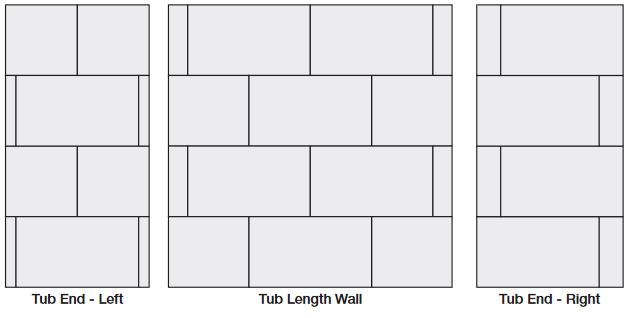
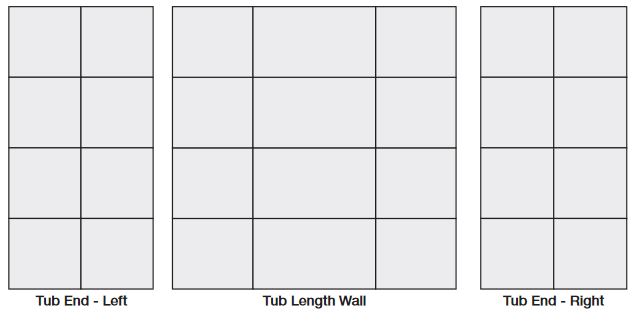
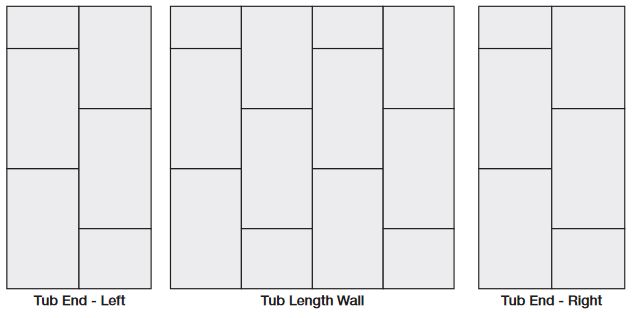

Determine Installation Type
Most tubs feature a lip or flange around the top perimeter to help prevent water leakage behind the tub. Each flange design is different and tile placement will vary to accommodate the design. You will need to determine your unique arrangement before beginning installation. Here, we discuss three typical arrangements beginning with the first row of tile closest to the top of the tub.
Over existing tile
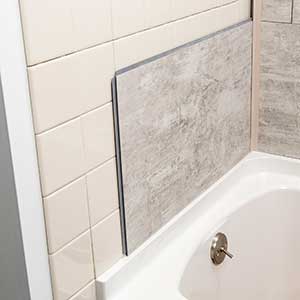
If you plan to apply Palisade over existing tile, the distance between the existing tile and the new Palisade may be so negligible that the Palisade tile can rest flush on the tub edge. In this case, simply seal the seam with silicone sealer around the perimeter.
In front of flange, over backer board
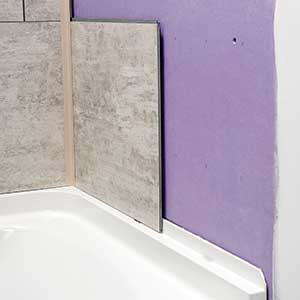
If applying Palisade tile over flange, there will be a slight angle to the tile to accommodate the flange before affixing to backer board. This angle is modest and can be concealed on either side of the surround with edge trim.
Flange behind backer board
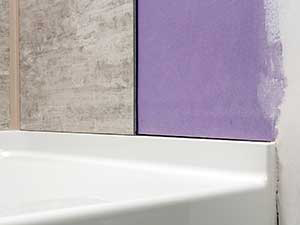
Apply Palisade to the backer board as you would with tile. In most cases the tiles will be flush to the surface or result in a negligible gap which, again, can be concealed with silicone or edge trim.
Edge Trims
This Tub and Shower Kit contains 2 (94-inch) Inside Corner Trims, 2 (94-inch) J-Trims (for termination edges) and 2 (94-inch) L-Trims (for use with edges over existing tile). Your installation type (above) will help determine which trims you will need.
Inside Corner Trims should be attached with adhesive to the substrate. Dispense a small bead of adhesive directly to the substrate corner or on the trim itself. Also dispense a bead of sealant into each of the trim’s channels to prevent water from reaching the substrate.
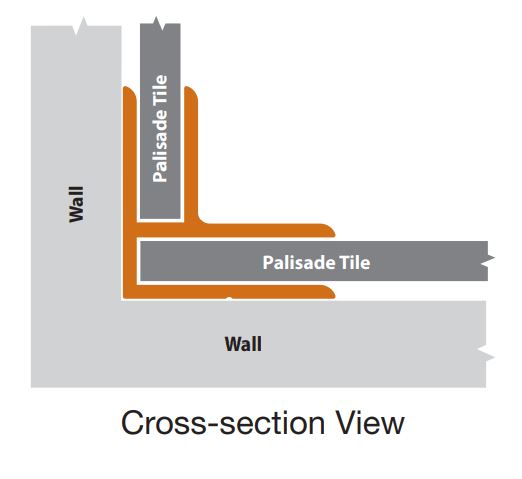

L-Trims are used to cover existing exposed tiles to provide a finished look. Install by dispensing a thin bead of sealant on the Palisade side and a thin bead of adhesive on the substrate side. Press trim into place. If trim will not stay in place, use some masking or painter’s tape to hold until adhesive sets.

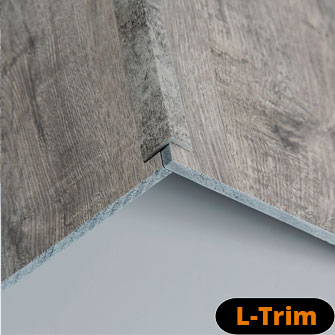
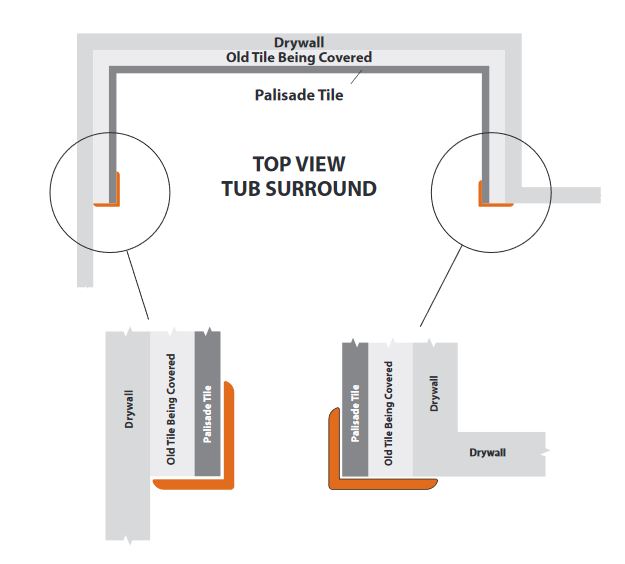
Measure walls, check for level and square. Depending on dimensions and surround size, you may need to trim some panels accordingly.
Installation in a wet environment such as a tub or shower surround requires a bead of sealant to be placed in all tongue and groove joints on every tile. Also, add a bead of sealant along cut edges or edges placed in corners (image 1, 2). Palisade tiles’ unique interlocking edges have a tongue and a groove. The tile’s tongue should be facing up when installing. This will prevent any moisture buildup.
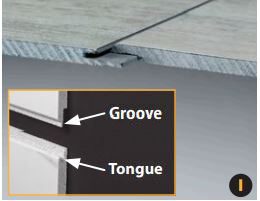


Repeat this process on perpendicular tile also facing corner (image 3, 4). If corner trims are used, sealant should still be applied in trim channel (image 5).



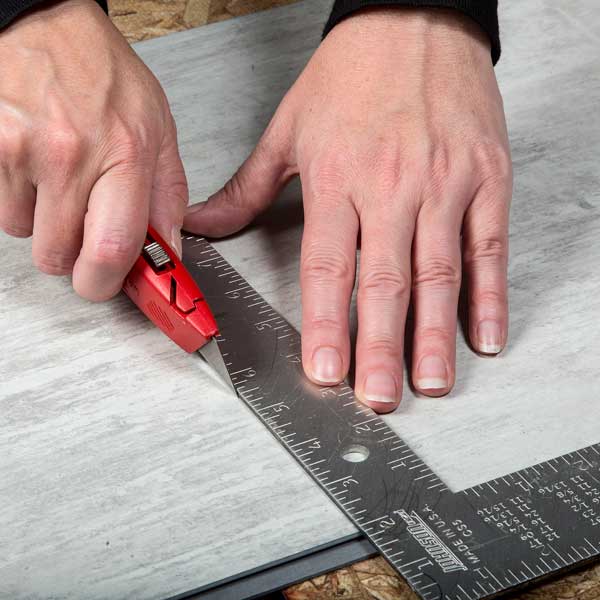

Cut Palisade tiles by scoring and snapping with a utility knife (image 6, 7). This method may require sanding the snapped edges.
You can also use standard wood working tools like a table saw or circular saw with a fine-tooth blade to provide a clean, smooth cut (image 8). Use a 60-tooth blade or higher. To ensure the base of the saw does not scratch the surface of the panel, we recommend protecting the surface with blue painter’s tape.
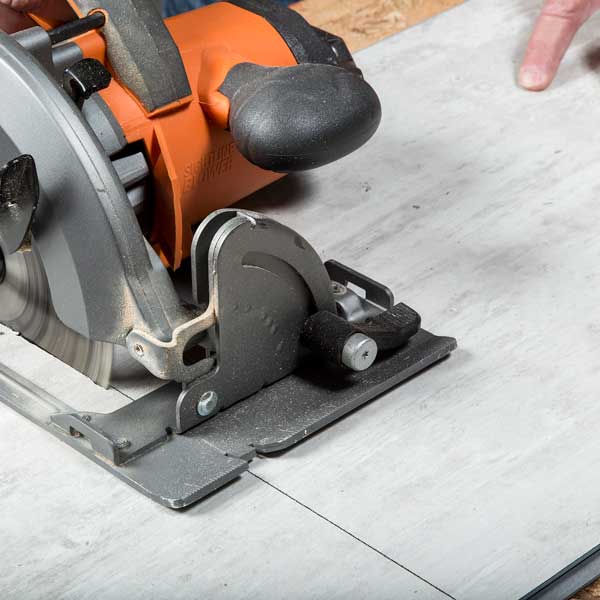
Cut panels to accommodate shower heads and faucets. Measure and mark the borders where the opening will be with a marker. Drill a 1/2-inch to 1-inch hole using a drill in a corner of the cut-out section (image 9). Use a jigsaw or hole saw to cut the remaining opening, following your tracing (image 10, 11).



Do not attach accessories like soap dishes, towel racks or shelves directly to tiles. Drill holes through the tiles and use suitable anchors to attach accessories securely into the framing behind. Seal with sealant.
Snap a level line. When starting your first row off a tub, be sure it is straight and level. Snap a level line and align the tops of each panel in the first row to the snapped line (image 12).

To install your first panel, begin with bottom row and work from left to right. Start bottom-left with a partial tile, so that you will have a full tile, centered in the middle of the first row (image 13, 14). That way, if you need to trim panels closer to the edges, you can use those extra pieces in other areas and minimize waste. The bottom flange should also be cut off of tiles when placing them on the floor or base of the tub. This will allow for a level edge on bottom. Use a utility knife or a table saw to cut the flange. If not using Inside/Outside Corner Trims and you are installing a full-size tile into a corner, the vertical flange or tongue must be cut off to allow for a plumb edge against the substrate.


Apply the panel to the substrate by pressing it into place. Apply even pressure with your hands across the entire panel. If necessary, use painter’s tape, shims or pins to hold panels in place until adhesive set Wipe off excessive adhesive. Use water and a cloth. Clean off any adhesive residue that is visible while it is still wet. Do not allow this residue to dry as it will be difficult to clean up when dry and could damage the finish Connect the next tile by fully inserting the tongue into the groove. Be sure to apply a thin bead (1/16 to 1/8-inch) of sealant to the connecting edge of each tile on both vertical and horizontal connecting seams (image 16, 17).
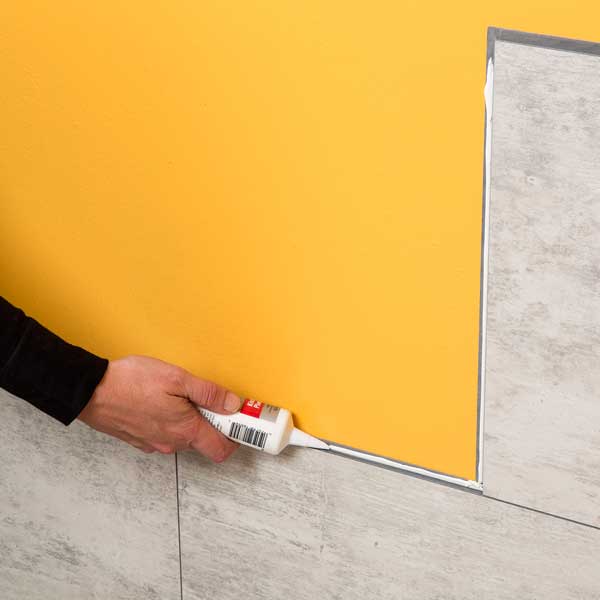
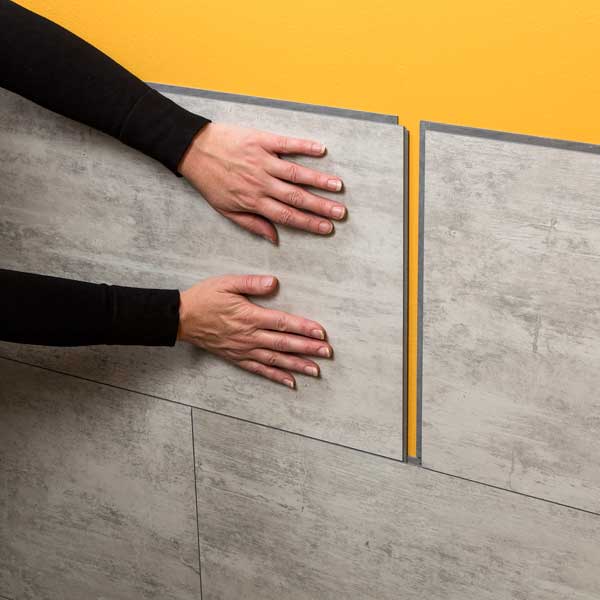
Repeat until bottom row is complete. If installing in a corner, cut off the flange of the tile facing the corner to allow a plumb surface against the substrate. Repeat this process on tile that abuts the previous one also facing the corner.
Allow the adhesive on the bottom row to set up. See adhesive manufacturer’s directions. The time necessary can vary from 20 minutes to several hours. After first row has set up, apply the remaining tiles according to the pattern or layout you desire. Use adhesive and methods described above for remaining rows.
Installation of Last Tile In a Row
If you are using corner and/or L-trims for a Palisade shower kit installation, the following information will show how to install the last, short tile at the end of a row. Read and follow if your project looks like this. Optional rubber gloves and water in a squirt bottle may make this task easier.
Showing where a short tile piece is needed to finish a row (image 18).
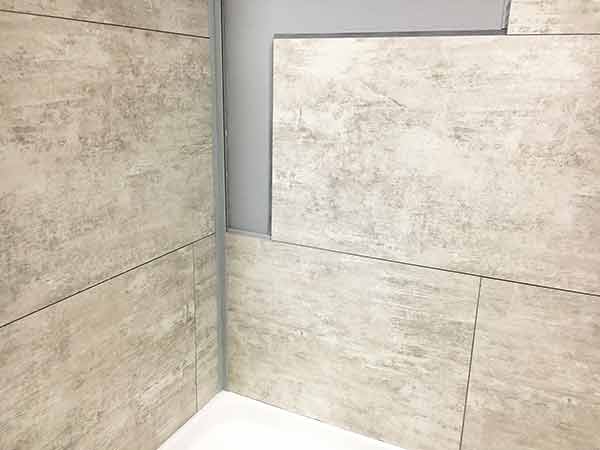
The challenge is to place the remaining tile section into the edge trim while also getting the interlocking tile edges locked together.
First, install the inside corner trims into each corner using adhesive. Make sure the corner trims are oriented as in the image right. Each inside corner trim piece has a full and a partial channel. The full channel will be against the back wall. The drawing (below) shows a top cross-section view of facing inside corners.

Next, determine the length of the tile section. Measure from the inside lip of the previously installed tile to the inside edge of the pre-installed trim. See image at right for details. In this case, the length to cut the final tile in the row is 4-3/4-inches (image 19).
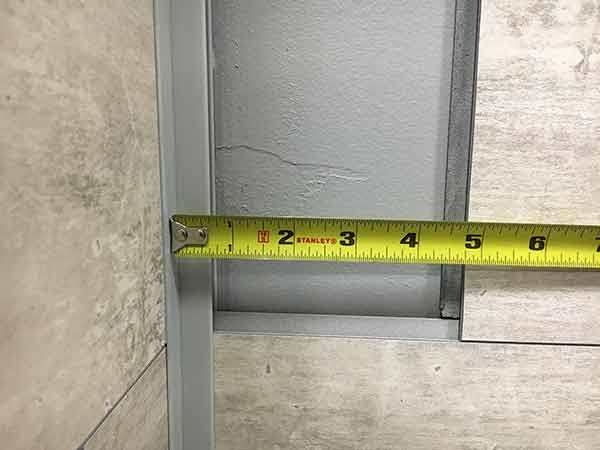
After cutting tile to length, apply adhesive to the substrate, as shown (image 20). Spray a squirt or two of water onto the substrate and adhesive, as shown (image 21). This will lubricate the substrate allowing for easier movement.
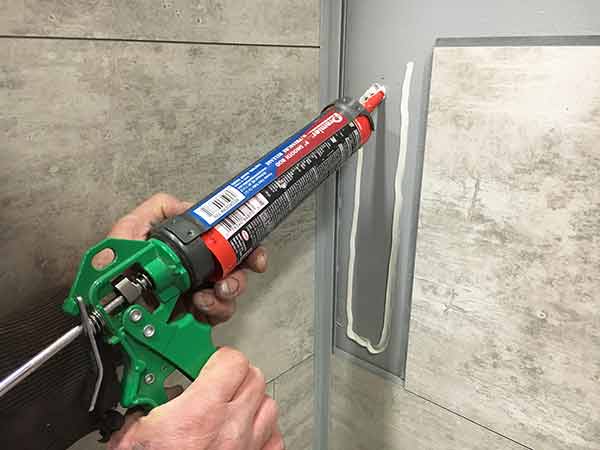

Insert the cut tile edge into the L-trim while holding the interlocking joint-edge away from its mating tile. Insert the cut end into the edge of trim channel while holding other edge up (image 22).
Push the tile into the edge trim while laying the tile down toward the substrate. When pushed into the trim entirely, the interlocking edges will be exposed (image 23).
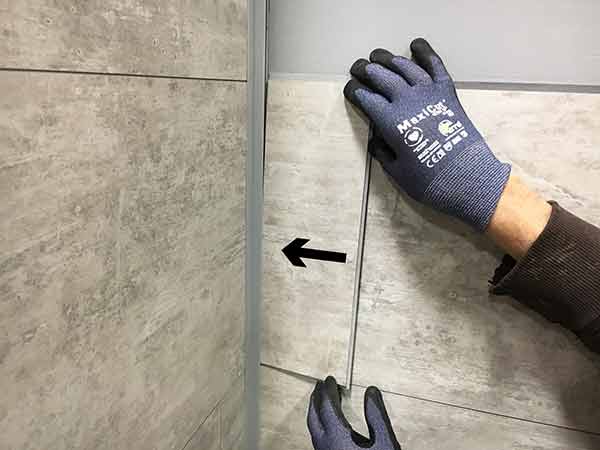

Apply sealant to the interlocking edges if this installation is for a wet environment.
The tile can now be manually pulled into place. Pull the tile toward the interlocking joint (image 24). If necessary, rubber gloves can be used to increase grip friction with the surface of the tile. Keep pulling until the interlocking joint is tight and in place (image 25).
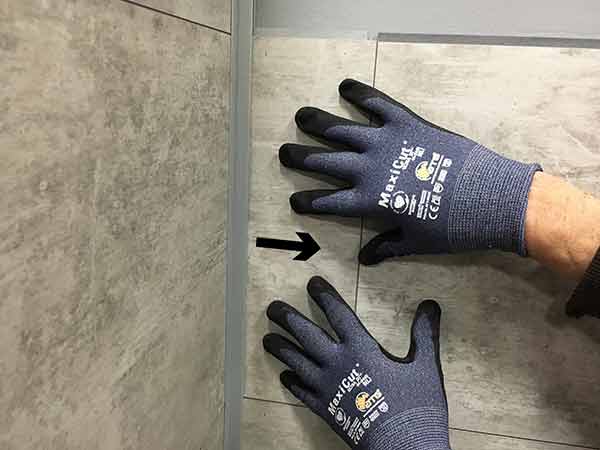

Use a damp rag or paper towel to clean off any sealant or adhesive that may have been squeezed onto the tile surface.


